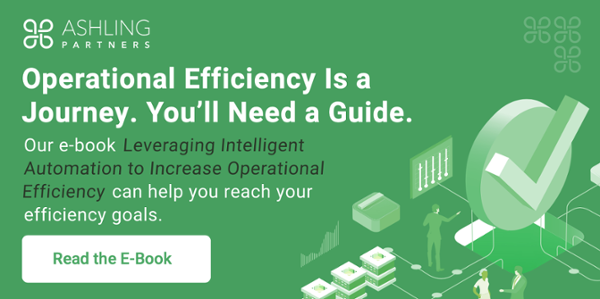Automation is everywhere in modern business practices. However, as the use of it grows within an organization, managing the numerous “digital robots” becomes cumbersome. If you’re using an robotic process automation (RPA) platform in the cloud, new unattended bots constantly run, even though most actively work only during certain parts of the day. This comes with a cost, creating the need for a better way to manage the bots. A new solution seeks to enable dynamic provisioning, scaling, and optimization, the UiPath elastic robot orchestration tool.
The concept is relatively new but focuses on the key thing that makes automation so advantageous, maximizing operational efficiency. In this post, we’ll review what elastic robot orchestration is, how it works, and why it’s a critical component in scaling RPA.
Driving Toward Scaled RPA
The drive to scale is part of any automation conversation. Most enterprises are using RPA to improve many processes, but there are important considerations when seeking to scale. Automation is a critical factor in efficiency, but how efficient is your RPA when bots are always on, even if they aren’t at work?
RPA is a system of “digital workers” that assume repetitive, rules-based tasks from humans. It eliminates the need for humans to perform the same activity over and over. Its adoption is soaring in many industries, from financial institutions to manufacturing.
The deployment of RPA often starts within one line of business. When the results show a dramatic impact on efficiency and productivity, leaders are eager to extend it to other departments.
Applying RPA makes it easy to build, implement, and deploy these robots into the ecosystem. As a result, they are a vital component of digital transformation efforts.
But what happens when the number of digital robots grows exponentially? It becomes a concern that orchestration can support.
Orchestration and RPA: Optimization of Virtual Machines
As the number of “digital robots” grows, the need to optimize scale and manage their capacity becomes more urgent. Crucial to this is saving virtual machine space and costs while the robots are idle. One approach that improves utilization is orchestration.
So, how do RPA and orchestration converge to support scale and efficiency?
Orchestration in RPA is already a model that many organizations use. It involves a set of preconfigured steps. With each step, an RPA script processes incoming data from an input message queue. They may then send these messages to output queues, which typically belong to the next step.
For the scalability of this exchange, UiPath Orchestrator is the web application that enables the full-scale orchestration of digital robots. The UiPath Orchestrator is the hub for creating, monitoring, scheduling, and controlling automated bots and processes.
The new iteration, the UiPath Elastic Robot Orchestration, expands the capabilities focusing on optimal usage of cloud properties. Elastic robot orchestration is an essential strategy for businesses that want to manage the capacity of digital robots better.
What Is Elastic Robot Orchestration?
If you’re looking for a solution to optimize RPA, elastic robot orchestration is an excellent option.
Elastic robot orchestration describes the automatic scaling of unattended bots in the cloud. When they are idle, they don’t put any strain on your virtual machines. It can work in a variety of cloud environments, including Amazon Web Services (AWS), Google Cloud Platform (GCP), and Microsoft Azure.
The UiPath-developed tool offers the ability to auto-scale. Because it’s an automated response, your organization doesn’t have to manage it manually. As you set up orchestration in your cloud, you can select from multiple configurations and controls to customize the solution to your specific environment and its demands.
While the work of the tool is in the background, it’s not a black box without visibility. Here’s how it works.
How Does the UiPath Elastic Robot Orchestration Work?
There are several options for auto-scaling. You can set a maximum number of machines to create within the elastic robot pool as one parameter.
Optimization within your robot pool is also a focus, and you can do so for speed, cost, or a combination of both with a balanced model.
Additionally, you can schedule different settings based on periods when you know you’ll need more or less speed. Think of the times of the month or year when the volume of specific bot tasks peaks. You can proactively prepare for this so you don’t face any operational challenges.
There are more ways to customize the orchestration relating to machine provisioning. The first approach is to use a generalized virtual machine image. You’ll use this as a template to construct machines on demand when a robot needs to complete a job. Within this, you can dictate limits of how many and when it creates machines.
The second possibility is to involve custom virtual machines to deploy robots when needed to run processes.
Generalized Virtual Machines vs. Custom Virtual Machines
Your objectives and type of processes could mean one option is better than the other. There are specific differences between the two in terms of machine usage and specific customizations. Scaling and setup are the same, with the only distinction being the virtual machine images.
Adding and deleting machines
With general virtual machines, they automatically create new ones when needed for performance and delete any not in use. For manually created machines, you generate them.
Machine scaling
Automatically created machines can generate as many bots as needed to handle the workload optimally within your set parameters. There isn’t a limit on the number of machines, but they are time consuming to build.
Virtual machine setup
The general option has a single virtual machine image. You can have multiple images with elastic robots; however, this requires different elastic robot pools for each type of image.
Virtual machine customization
With the manual process, you can customize in many ways, including domain-joined, machine size, machine name, network, and more. The automatic option requires you to configure the virtual machine image as cloud providers recommend.
For all other components, the two options provide automation for installing and setting up robots on each machine, connection to the orchestrator, running jobs, and starting and stopping virtual machines.
Machine scaling
You can generate as many bots as needed to handle the workload optimally within your set parameters. There isn’t a limit on the number of machines, but they are time consuming to build.
Virtual machine setup
You can have multiple images with elastic robots; however, this requires different elastic robot pools for each type of image.
Elastic Robot Orchestration Benefits
So, why should you consider elastic robot orchestration for your RPA ecosystem? You can realize many advantages by leveraging this tool in the categories of costs, capacity, and acceleration.
Reduce Costs with Orchestration
The UiPath elastic robot orchestration solution helps reduce operating costs. Further, it can lower the overhead expenses associated with management, patching, and required upgrading. For any enterprise, these are considerable expenses, and the impact of the savings can be substantial and enable the reallocation of budget dollars.
Eliminate the Capacity Guessing Game
You can stop speculating about capacity, which often involves pre-warming the virtual machines running the robots. You’ll know exactly the workflows of your bots.
Speed Up Time to Value
Another benefit is acceleration automation projects. Getting these started can be time-intensive, and orchestration quickens the pace. As a result, you could experience time to value much faster.
When to Use Elastic Robot Orchestration
The need for the tool typically formulates when an enterprise wants to scale RPA and/or has capacity or cost concerns. The move may also come when you need to remove burdens from internal resources.
Here’s a use case for how it can deliver results for your organization.
An automation may run for a set time of day, such as 7 a.m.-11 p.m. Its peak hours are between 3 p.m. and 6 p.m., using 150 bots. In an existing framework with elastic robot orchestration, you’re paying for these bots to be ready for the entire time span. For most of the interval, you only need 20 bots. So, when you deploy orchestration, you’re conserving resources. You only release all of the bots at the peak times, then reduce them back to 20. The outcome is reduced costs and utilization within your cloud.
Elastic robot orchestration is just one of the ways you can improve operational efficiency with automation. Get more insights with our ebook, Leveraging Intelligent Automation to Increase Operational Efficiency.



